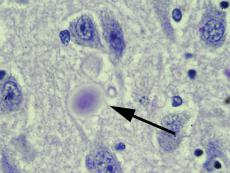Parkinson’s disease is a progressive neurodegenerative disease that affects about 1 in every 500 people in the UK. There is no biochemical test to definitively diagnose Parkinson's disease; diagnoses are instead made on the basis of various clinical assessments. Parkinson's disease is, however, characterized by the presence of Lewy bodies (LBs) - tiny protein deposits in nervous tissue.

LBs can only be identified from a tissue sample, which is then stained and examined under a microscope (see right). These proteins tend to accumulate in the central nervous system and in the sympathetic ganglia, nervous tissue that runs like train tracks down either side of the spine - places that are nearly impossible to get biopsy samples.
In this study, the authors looked for LBs in various tissues in 279 patients undergoing autopsy. A total of 85 patients had evidence of LBs in their central nervous system, so were diagnosed as having had a LB disease (LBD) - Parkinson's with or without dementia, dementia with LBs or LB-related progressive autonomic failure.
The authors then examined skin biopsy samples taken the patients with proven LBD and found that 20 (23.5%) patients showed LB pathology in the cutaneous nerves of skin samples. None of the 194 individuals who did not have LBD showed evidence of LBs in skin samples; therefore, the skin test didn’t mistakenly identify any patients as having LBD.
More specifically, LBs were found in the skin of 70% of patients who had Parkinson’s disease with dementia and in 40.4% of those who had dementia with LBs. On the other hand, LB pathology was found in the skin of only 20% of patients who had subclinical LBD, i.e. patients who would have had few symptoms of LBD but not enough signs to meet all the criteria for a diagnosis. This skin biopsy test might not, therefore, be a useful test for early diagnosis in individuals suspected of having LBD.
When the authors looked at the clinical records of the patients that they had autopsied, they found that LBD patients who had evidence of LB pathology in their skin were more likely to have been bedridden and unable to walk independently before they died than were those patients with LBD who did not have cutaneous LB pathology (P<0.001 style="font-style: italic;">P=0.065, respectively). This finding suggests that skin biopsy testing could be used to predict which patients’ physical functioning might be affected most seriously by their disease, and physiotherapy could be prescribed accordingly.
Ikemura et al.’s study is the first to find evidence of LB pathology in the skin of patients with LBD; however, their results do not support the use of skin biopsy as an early diagnostic test. Testing for LBs in the skin could be used to confirm the diagnosis in a patient with clinical Parkinson’s disease or dementia with LBs and to predict the effect the disease might have on their physical functioning, both of which could help clinicians tailor treatment.
------------------------------------------------------------------------------------------------------------------
Ikemura M, Saito Y, Sengoku R, Sakiyama Y, Hatsuta H, Kanemaru K, Sawabe M, Arai T, Ito G, Iwatsubo T, Fukayama M, Murayama S (2008). Lewy Body Pathology Involves Cutaneous Nerves. J Neuropathol Exp Neurol, 67 (10), 945-953 PMID: 18800013
1 comment:
I was diagnosed with Parkinson's disease in my mid to late 40's. I had hand tremors for several years. Gradually became worse. I then noticed when I was tired the tremors were worse. I started falling for no apparent reason. I now have stiffness in my legs and need to walk with 2 canes or a walker. I am very slow getting around. I am now 52 years old. I am forgetful at times and have difficulty expressing myself. I have difficulty swallowing at times. I become tired easily, I also become quite dizzy when performing any athletic function (jogging). I was on Levodopa/Carbidopa, 100/25. nothing was really working to help my condition. Finally i started on parkinson's herbal formula i purchased from Health Herbal Clinic, i read alot of great reviews from other patients who used the parkinson's herbal treatment. I used the herbal remedy for 7 weeks, its effects on parkinson's is amazing, all My symptoms gradually faded away, I have been active and hope to continue! (Visit www. healthherbalclinic. net or email at info@ healthherbalclinic. net) I recommend this Parkinson's herbal formula for all Parkinson's Patients.
Post a Comment